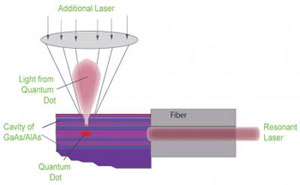Lasers Tune Quantum Dots
In what could be a key development in cryptography applications, researchers from the National Institute of Standards and Technology (NIST) and the Joint Quantum Institute (JQI), a collaborative center of the University of Maryland and NIST, have found a way to reduce light scattering from quantum dots by manipulating them with lasers.This new technique improves quantum dots as a source of pairs of “entangled” photons, which are a peculiar consequence of quantum mechanics. Tricky to generate, they remain interconnected even when separated by large distances. Merely observing one instantaneously affects the properties of the other. The entanglement can be used in quantum communication to pass an encryption key that is by its nature completely secure, as any attempt to eavesdrop or intercept the key would be instantly detected. One goal of the NIST-JQI team is to develop quantum dots as a convenient source of entangled photons.
Schematic of NIST-JQI experimental set up. Orienting the resonant laser at a right angle to the quantum dot light minimizes scattering. Photo courtesy of Solomon/NIST.
Quantum dots are nanoscale regions of a semiconductor material similar to the material in computer processors, but with special properties due to their tiny dimensions. Though they can be composed of tens of thousands of atoms, quantum dots in many ways behave almost as if they were single atoms.
Unfortunately, almost is not good enough when it comes to the fragile world of quantum cryptography and next-generation information technologies. When energized, a quantum dot emits photons, or particles of light, just as a solitary atom does. But imperfections in the shape of a quantum dot cause what should be overlapping energy levels to separate. This ruins the delicate balance of the ideal state required to emit entangled photons.

Cross-section scanning tunneling microscope image shows indium arsenide quantum dot regions embedded in gallium arsenide. Each 'dot' is approximately 30 nanometers long; faint lines are individual rows of atoms. (Color added for clarity.) Photo courtesy of J.R. Tucker.
To overcome this problem, the NIST-JQI team has discovered that they can use lasers to precisely control the energy levels of quantum dots, just as physicists have been doing with actual single atoms since the mid-1970s and, much more recently, with the artificial quantum dot variety.
With their customized set-up, which includes two lasers, one shining from above the quantum dot and the other illuminating it from the side, the researchers were able to manipulate energy states in a quantum dot and directly measure its emissions. By adjusting the intensity of the laser beams, they were able to correct for imperfection-caused variations and generate more ideal signals. In so doing, the team was the first to demonstrate that laser-tuned quantum dots can efficiently generate photons one at a time, as required for quantum cryptography and other applications.
While the device currently still requires quite cold temperatures and sits in a liquid helium bath, it is compact enough to fit in the palm of your hand—an elegant setup that could be eventually implemented in quantum cryptography applications.
For more information, visit: www.nist.gov
LATEST NEWS
- CLEO Heads to the East Coast Apr 29, 2024
- Laser-Based Gas Analyzer Developed to Detect Air Pollution Apr 29, 2024
- Qubits Could be Stored in Flash-Like Memory Apr 29, 2024
- Exail Signs LLNL Contract, Partners with Eelume Apr 26, 2024
- Menlo Moves U.S. HQ: Week in Brief: 4/26/2024 Apr 26, 2024
- Optofluidics Platform Keys Label-, Amplification-Free Rapid Diagnostic Tool Apr 25, 2024
- DUV Lasers Made with Nonlinear Crystals Enhance Lithography Performance Apr 25, 2024
- Teledyne e2v, Airy3D Collaborate on 3D Vision Solutions Apr 24, 2024
